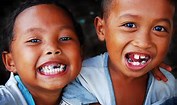![]()
![]()
![]()
![]()
![]()
![]()
![]()
![]()
![]()
Optician explains how a baby’s sight develops - and the first colour they see is red
Did you know that the very first colour a baby can see is red? And that while healthy babies are born with the ability to see, they can't focus their eyes or move them accurately until later in their development?
No, we didn't either, but we do now thanks to Sharon Copeland, an optician from Feel Good Contacts who has revealed everything you need to know about the development of your baby’s vision.
The expert has explained a number of different stages of a baby's vision development so parents can understand more about their bundle of joy.
She said: "Babies' eyes first start to change in the first couple of months when their eyes begin to work together more effectively. Other milestones in the development of a baby's vision occur at around four months, five to eight months and nine to 12 months."
And what about colour?
According to Sharon, it is believed that babies begin to see colours well and clearly at around five months.
She explains: "Their colour vision may not be as clear as that of an adult, but it will have developed dramatically compared to when they were one month old and couldn’t tell the difference between similar tones.
"A baby begins to distinguish between similar tones at around two months old. The first colour they will be able to see is red, and by the time they are five months old, they will be able to see the whole colour spectrum."
As well as sharing this, Sharon has also broken down the vision milestones your child will face as they grow and develop from being a newborn baby during their first year.
© Getty Images A mum looking at her sleeping baby
Newborn babies experience the world around them as being out of focus and can best see objects between eight to 10 inches away from them. In the first couple of months, newborn eyes will start to function better together; however, they might not coordinate effectively yet.
It is normal for one eye to wander or for both eyes to appear crossed in most instances. However, if you notice wandering or crossed eyes too often, it may be worth speaking to a paediatrician.
At around three months, a baby will develop hand-eye coordination. You may notice their eyes following a moving object while reaching out to it with their hands.
Five to eight months
During the next five to eight months, a baby's eyesight will change dramatically. They will pick up new skills and acquire depth perception to determine how close or far away objects are around them. This will improve their hand-eye coordination and at around eight months of age, many babies will begin to crawl, which will aid hand-eye coordination even further.
A baby’s colour vision will also improve during this period.
Nine to 12 months
By the time a baby is one year old, their vision will be fully developed, and they will be able to see things very clearly, judging distances well and focusing on fast-moving objects.
W hen should you get your baby’s eyes get checked?
Sharon adds: "It’s normal for a number of routine eye checks to be carried out during the first few years of a baby’s life. A newborn will undergo a physical examination 72 hours after birth, and a follow-up eye check will take place when your baby is between six to eight weeks old.
"You will be offered health and development reviews for your baby until they are two years old to ensure that their development is on track. If you have any concerns about your child's eyesight, you will be asked at these reviews, and an eye test can be arranged if necessary.
"Your child may have an eye exam at around the age of four or five when they start school to detect any problems early on and treat them. This eye exam is called a vision screening and checks to see if there is reduced vision in one or both eyes.
"Engaging with your baby will encourage their development. Talking to your baby and pointing out things you see, taking them to new and interesting places and naming objects when you speak to your baby are all things you can do to help them process visual information.
"Make sure that you pay attention to any signs or symptoms that could indicate a problem with their vision, and speak to a doctor if you have any concerns."
Reference: Mirror: Courtney Pochin
- Nine things you must consider before adopting a child
- An Overview of Psoriasis in Children
- DIY Fertility Tests Are On The Rise, But How Reliable Are They?
- Dentist shares when children should stop using dummies - or risk bite issues
- Top 10 benefits of breastfeeding
- Reye's syndrome: The illness that affects children
- Diphtheria symptoms: Everything you need to know after case confirmed at UK school
- Children with 'prominent' forehead may in fact be suffering from a dangerous illness
- Study assesses links between early negative life events, orbitofrontal cortical thickness and depression in young adults
- Placenta tumour: My miracle baby gave me cancer
- 7 things to look out for when it comes to vaginal health, according to gynaecologists
- What is the vaginal microbiome?
- What every woman should know about hormones, the pill and cancer
- Doctors sound alarm over new infant fentanyl syndrome
- How to boost your child’s memory
- How to Teach Deaf Children to Read
- Speaking to babies in sing-song speech ‘helps them learn language’
- Enzyme therapy approved for rare genetic condition in babies
- Paris Hilton opens up about decision to have children via surrogate
- Urgent, gentle care: life on a neonatal unit
- Woman, 70, 'gives birth to twins after IVF treatment': Ugandan becomes the oldest person to give birth in Africa, hospital says
- Scarlet fever symptoms: What parents should look out for as UK cases surge by 70 per cent
- Vaccine to tackle bronchiolitis to be offered to children next year
- What is baby-led weaning?
- What are the symptoms of tonsillitis and how is it treated?
- Home
- Aches and Pains
- Children - Insomnia
- New Born Babies
- Babies From 2-12 months
- Spina Bifida
- Equipment Used
- Drug Abuse
- Other Ingredients
- The Handicapped Child
- Videos
- BALANITIS - Aromachildhood
- Worms
- Corona virus and pregnancy
- Contact Us
- Essential Oils for General Purposes
- The Methods - Aromatherapy - Children-2
- Hydrolats, Essential Oil Waters, and infused Oils
- Ringworm
- The Methods - Aromatherapy - Children- 3
- Basic Care Kit - Children - Essential Oils
- Web Links
- Acne
- Adolescent Acne
- The A - Z of Conditions
- Arthritis (juvenile Rheumatoid)
- Herbal Healing Infused Oils
- The Cave Man Eating Plan
- Things To Make For Your First Aid Cabinet
- The Basic Care Kit For Children
- Verrucas and Warts
- Caring Touch Massage
- The Methods - Aromatherapy - Children
- The Methods - Aromatherapy - Children - 4
- Athlete's Foot - 2
We have 38 guests and no members online







